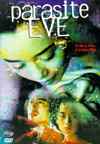Parasite Eve
Before you PlayStation fans reach for your wallets, allow me to warn you that the film version of ’Parasite Eve’ has nothing to do with the lovely Aya Brea and the gun-toting antics which she performs in the popular video-game series. This Japanese film is based on the original ’Parasite Eve’ source novel by Hideaki Sena and is more of a ’Frankenstein’ love-story, than an action film. While the movie does share some thematic traits with the games, this film is much more subtle and disturbing.
Hiroshi Mikami stars as Dr. Nagashima, a scientist who has discovered that mitochondria, the organsims which provide energy for cells, appear to have their own DNA and life-cycle. Nagashima has put this theory to work in his research, as he attempts to cure diseases in lab animals, using the mitochondrian energy. When Nagashima’s young wife Kiyomi (Riona Hakuzi) is killed in an auto accident, Nagashima takes her liver in order to try and clone her, once again, using the energy of the mitochondria. What Nagashima doesn’t realize is that Kiyomi’s death may be the first step in an evolutionary leap, in which the mitochondria will rise up and dominate the world.
Given this plot synopsis, one can tell that ’Parasite Eve’ is indeed an unusual film. The first twenty minutes of the film plays as a science lesson, as we learn all about the mitochondria. And while director Masayuki Ochiai has given the film a very deliberate pace, he never allows things to get too slow. Ochiai’s style is somewhat similar to that of David Lynch, especially in the way he uses sound, or at times, the absence of sound, to punctuate a scene. Also, Ochiai has a very strong visual sense, and there are some great shots to be had here. The ’Frankenstein’ theme is driven home a bit too hard at times, especially when Nagashima returns to his lab during a lightning storm. The ending of ’Parasite Eve’ is somewhat confusing and convoluted, but the scenes leading up to the finale are very disturbing and contain some great imagery. ’Parasite Eve’ is not the best example of a Japanese horror film, but those of you who’ve grown bored with homegrown fare may want to ’experiment’ with it.
’Parasite Eve’ evolves onto DVD courtesy of ADV Films, in glorious anamorphic widescreen which has been letterboxed at 1.85:1. The image here is simply beautiful. Aside from an occasional white spot, there are no defects from the source print. The picture is sharp and clear, rarely showing any grain. The most outstanding aspect of this transfer are the colors. The reds, blues, and greens simply leap off of the screen, and the fleshtones all appear natural. This great image gives the picture a great deal of depth, thus adding to Ochiai’s visuals. The framing appears to be accurate, as there is no warping of the frame. Given the hit or miss nature of the image quality of Asian films on DVD, I was truly impressed with this transfer.
The audio on this DVD is a Dolby 2-channel Surround track. The soundtrack offers clear and audible dialogue and no his or distortion is present. The surround sound is used mainly for ambience, but in certain scenes, such as the storm, it does make its presence known. There were some problems with the recording level, as the volume would suddenly shift from loud to soft, but this occurred infrequently during the film. The English subtitles are white, and easy to read, but they do appear on the image itself. The only extra on the DVD is a trailer for the film, which is presented full-frame. Running only 48 seconds, the trailer gives one little indication of what the film is about.

